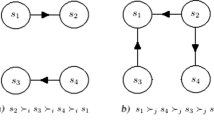Abstract
A hybrid preference framework is proposed for strategic conflict analysis to integrate preference strength and preference uncertainty into the paradigm of the graph model for conflict resolution (GMCR) under multiple decision makers. This structure offers decision makers a more flexible mechanism for preference expression, which can include strong or mild preference of one state or scenario over another, as well as equal preference. In addition, preference between two states can be uncertain. The result is a preference framework that is more general than existing models which consider preference strength and preference uncertainty separately. Within the hybrid preference structure, four kinds of stability are defined as solution concepts and a post-stability analysis, called status quo analysis, which can be used to track the evolution of a given conflict. Algorithms are provided for implementing the key inputs of stability analysis and status quo analysis within the extended preference structure. The new stability concepts under the hybrid preference structure can be used to model complex strategic conflicts arising in practical applications, and can provide new insights for the conflicts. The method is illustrated using the conflict over proposed bulk water exports from Lake Gisborne in Newfoundland, Canada.
Similar content being viewed by others
References
Brams S.J. (1993) Theory of moves. Combridge University Press, Cambridge, U.K.
Brams S.J., Wittman D. (1981) Nonmyopic equilibria in 2 × 2 games. Conflict Management and Peace Science 6(1): 39–62
Daniel D. (2000) Conflict resolution. McGraw-Hill, New York
Fang L., Hipel K.W., Kilgour D.M. (1993) Interactive decision making: The graph model for conflict resolution. Wiley, New York, USA
Fang L., Hipel K W., Kilgour D.M., Peng X. (2003a) A decision support system for interactive decision making, Part 1: Model formulation. IEEE Transactions on Systems, Man and Cybernetics, Part C 33(1): 42–55
Fang L., Hipel K.W., Kilgour D.M., Peng X. (2003b) A decision support system for interactive decision making, Part 2: Analysis and output interpretation. IEEE Transactions on Systems, Man and Cybernetics, Part C 33(1): 56–66
Fang L., Hipel K.W., Wang L. (2002b) Gisborne water export conflict study. Proceedings of 3rd International Conference on Water Resources Environment Research 1: 432–436
Fischer G.W., Jia J., Luce M.F. (2000a) Attribute conflict and preference uncertainty: The randmau model. Management Science 46(5): 669–684
Fischer G.W., Luce M.F., Jia J. (2000b) Attribute conflict and preference uncertainty: Effects on judgment time and error. Management Science 46(1): 88–103
Fraser N.M., Hipel K.W. (1979) Solving complex conflicts. IEEE Transactions on Systems, Man, and Cybernetics 9: 805–817
Hamouda L., Kilgour D.M., Hipel K.W. (2004) Strength of preference in the graph model for conflict resolution. Group Decision and Negotiation 13: 449–462
Hamouda L., Kilgour D.M., Hipel K.W. (2006) Strength of preference in graph models for multiple-decision-maker conflicts. Applied Mathematics and Computation 179: 314–327
Howard N. (1971) Paradoxes of rationality: Theory of metagames and political behavior. MIT press, Cambridge, MA
Kilgour D.M. (1984) Equilibria for far-sighted players. Theory and Decision 16: 135–157
Kilgour D.M. (1985) Anticipation and stability in two-person noncooperative games. In: Ward M.D., Luterbacher U. (eds) Dynamic model of international conflict. Lynne Rienner Press, Boulder, CO, pp 26–51
Kilgour D.M., Fang L., Hipel K.W. (1990) A decision support system for the graph model of conflicts. Theory and Decision 28(3): 289–311
Li, K. W., Hipel, K. W., Kilgour, D. M., & Fang, L. (2002a). 2 × 2 games with uncertain ordinal preferences. In Proceedings of the 2002 international conference on control, automation (pp. 1471–1475). Xiamen: China.
Li, K. W., Hipel, K. W., Kilgour, D. M., & Fang, L. (2002b). Stability definitions for 2-player conflict models with uncertain preferences. In Proceedings of the 2002 IEEE international conference on systems, man and cybernetics, Vol. 7, pp. 13–18.
Li K.W., Hipel K.W., Kilgour D.M., Fang L. (2004) Preference uncertainty in the graph model for conflict resolution. IEEE Transactions on Systems, Man, and Cybernetics Part A: Systems and Humans 34(4): 507–520
Li K.W., Hipel K.W., Kilgour D.M., Noakes D.J. (2005a) Integrating uncertain preference into status quo analysis with applications to an environmental conflict. Group Decision and Negotiation 14: 461–479
Li K.W., Kilgour D.M., Hipel K.W. (2005b) Status quo analysis in the graph model for conflict resolution. Journal of the Operational Research Society 56: 699–707
Myerson R.B. (1991) Game theory: Analysis of conflict. Harvard University Press, Cambridge, MA
Nash J.F. (1950) Equilibrium points in n-person games. Proceedings of the National Academy of Sciences 36: 48–49
Nash J.F. (1951) Noncooperative games. Annals of Mathematics 54(2): 286–295
Pawlak Z. (1998) An inquiry into anatomy of conflicts. Journal of Information Sciences 109: 65–78
Saaty T.L. (1986) Axiomatic foundation of the analytic hierarchy process. Management Science 32(7): 841–855
Saaty J.M., Alexander T.L. (1989) Conflict resolution: The analytic hierarchy approach. Praeger Publishers, New York
von Stackelberg H. (1934) Marktform und Gleichgewicht. Springer, Vienna
Xu, H., Hipel, K. W., & Kilgour, D. M. (2008). Preference strength and uncertainty in the graph model for conflict resolution for two Decision-Makers. In Proceedings of the IEEE international conference on systems, man and cybernetics, Vol. 1, 2907–2912.
Zagare F.C. (1984) Limited-move equilibria in 2 × 2 games. Theory and Decision 16: 1–19
Author information
Authors and Affiliations
Corresponding author
Rights and permissions
About this article
Cite this article
Xu, H., Hipel, K.W., Kilgour, D.M. et al. Combining strength and uncertainty for preferences in the graph model for conflict resolution with multiple decision makers. Theory Decis 69, 497–521 (2010). https://doi.org/10.1007/s11238-009-9134-6
Received:
Accepted:
Published:
Issue Date:
DOI: https://doi.org/10.1007/s11238-009-9134-6




